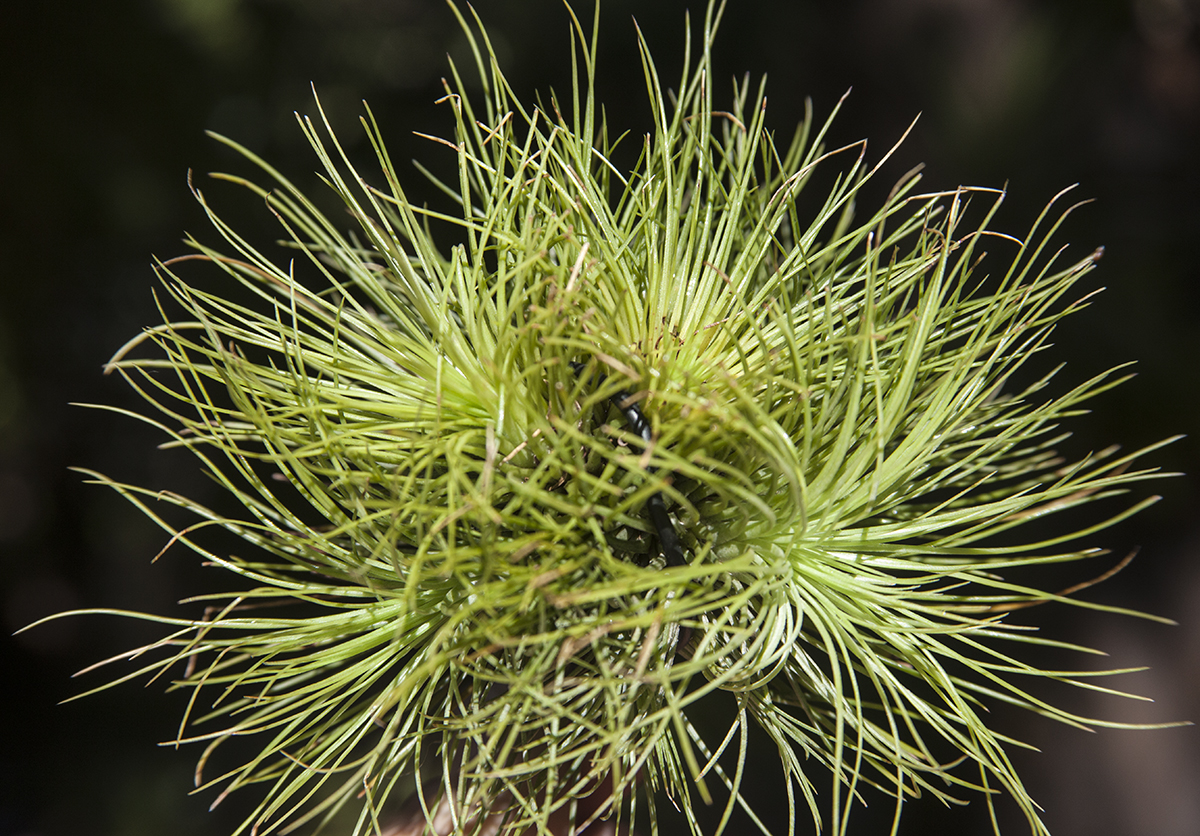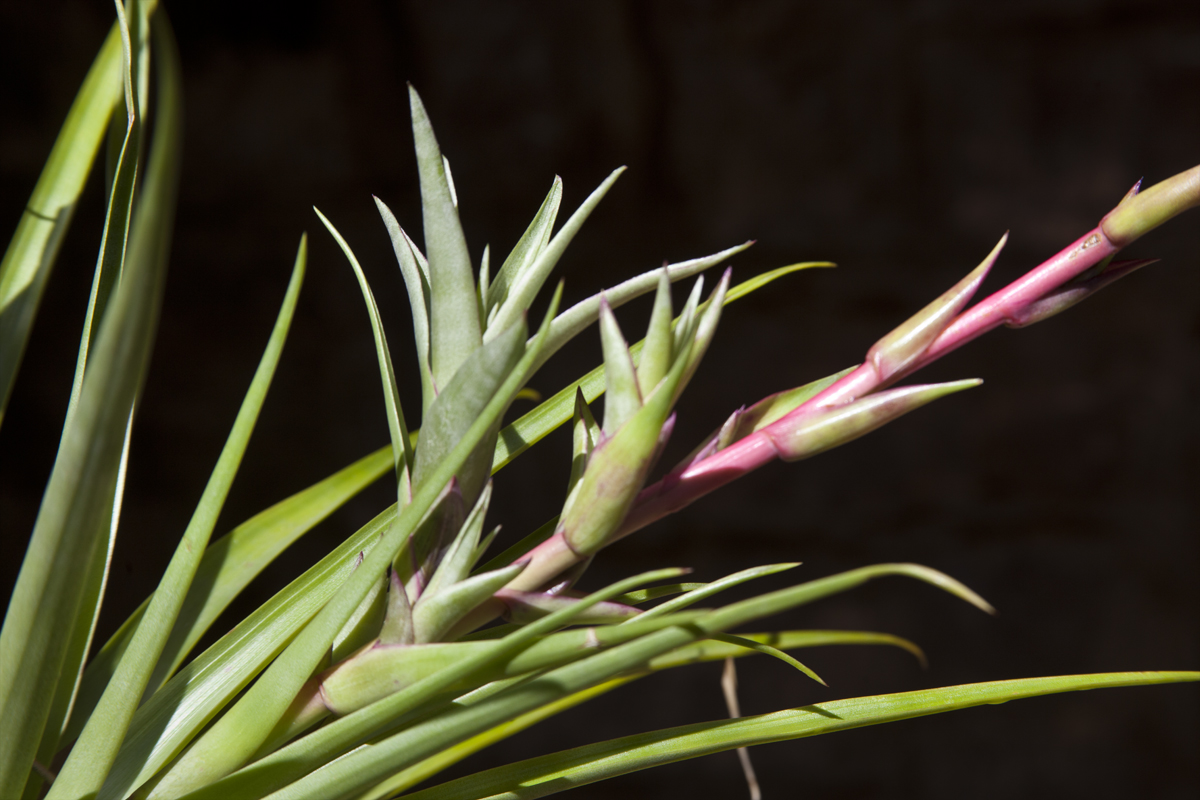A
catalogue of Bromeliads used for various projects by - © Lloyd Godman
This
is a catalogue of bromeliads used by Lloyd godman for his various installations
and photosynthesis projects - the collection of pants he accessed in
New Zealand from 1996 - 2004 was collected from a wide range of sources,
while most were brought from Greens Bromeliads, some were also donated
by the Dunedin Botanical Gardens. Later in 2004 these plants were either
sold or given away with his move to Australia.
Lloyd is at present re-establishing his collection where he now lives
in Melbourne.
A
Lexicon of Bromeliads: A
resource by Lloyd Godman
Genus - Tillandsia: Sub-Family - Tillandsioideae: Family - Bromeliad
Tillandsias
are regarded as true air plants and as such are among the most unusual
of the Bromeliad family. They range from bulbous forms and grass like
structures to silver tufted masses. Typically they grow where there
is free air movement like high treetop environments or across open rock
faces, and often they are heavily covered in silver trichomes that help
reflect the high levels of sun light they receive in these locations.
While some tolerate temperatures as low as 5 degrees C (40 degrees F),
or even lower, most prefer temperatures of around 10-32 degrees C (50-32
degrees F). While they require high levels of humidity, they need to
dry out quickly and completely between misting or watering. As the trichome
scales open to absorb moisture and close to retain it, it is important
that the plants are given time to dry out and most plant deaths occur
because of over watering.
Why do some Tillandsias die?
One pair of shoes will not fit all feet. Firstly, consider that there are over 1,000 species of Tillandsia and the optimum growing conditions across the entire genus vary considerably. What one plant responds to may be ultimate death to another. Understanding the climatic conditions of the natural habitat of a species gives useful information of how to grow a particular plant.
|

|
Natural Genetic Causes: Most Tillandsias are what is termed Asexual plants, that is they grow to maturity, flower and then produce small off sets called pups that usually form from the base or stem of the old plant. Some species like Tillandsia secunda are termed viviparous, they produce pups from the flower stem. It is intriguing, that in theory these amazing plants can actually live for ever. In fact, there may be some Tillandsia plants growing today that have continued to reproduce Asexually from the original seed parent that germinated many thousands of years ago. The mystery is we have no way of telling. However, there are a few Tillandsia species like Tillandsia utriculata that have a different genetic code so after a parent flowers, the plant dies and produces no pups. Cultivating these plants will surely result in death at the end of the plant’s life, and they are only perpetuated from seed.
While talking about genetics, it is valuable to consider that from any batch of Tillandsia seed there will be variations between individual plants that mean some are more resilient to cold, heat, dry, wet etc. It maybe that one plant can withstand -3°C degrees of frost while another sister plant can only tolerate -1 degrees. Purchasing similar species of plants from a range sources can reveal distinct differences.
Over many generations, through Asexual reproduction, individual plants can actually adapt to grow better in a particular situation. Adaption can be extended even further where plants with a wider range of tolerances evolve through generation after generation of seed reproduction. This happens in the wild and cultivation.
|

Tillandsia secund with viviparous pups forming on the stem. |
Heat: While different species can tolerate varying amounts of heat, consider that with many plants heat is also linked to humidity. While plants like T. tectorum have been recorded withstanding amazing heat, 55°C in direct sun, other species might fail at temperatures just over 30C. Generally, as the temperature increases the plants respond to a higher humidity level, so in cultivation, with higher temperatures Tillandsias respond to regular misting. A specific Tillandsias may tolerate say 45°C in a shady location but suffer at 40°C when exposed to direct midday sun for prolonged periods.
However, in very hot weather, make sure that plants are watered early in the morning and have time to dry out before the hot direct rays of the sun fall on the leaves. (in summer I water about 6-7am). I once had a friend who was looking after the property during a very hot period of weather (5 days over 40°C). They thought they were helping by watering the garden which included Tillandsias at 11am with a burning sun. Watering at this time did huge damage to many plants including the Tillandsias which had the protective silver trichome cells fried and left the plants vulnerable to dehydration. In many Tillandsias the silver trichome acts as a protection against extreme UV and reflects up to 93% of these rays. Some of the effected plants died while others took as long as 3 years to recover.
If the leaf tips die off, this is a sign of heat and low humidity.
|
|
Cold: Cold can be harmful to some Tillandsias and combined with persistent dampness can be a killer. There are some species like T. dyeriana that can only be grown in warm conditions where the temperature never drops below 12c where and climate is relatively stable. However, many Tillandsia can survive through a cool winter down to 3-5°C, but when the temperature drops to below 12°C it is wise to reduce watering or even withhold water altogether. I have ignored plants in mid-winter for 2 months with no water at all and they have been fine. If water is applied in low temperatures it is crucial that the trichome cells dry out quickly or the leaf tissue can rot. This is particularly so with plants like T. ionatha and T.prinosa. In cooler weather, water during the warmer part of the day and make sure the plants dry out quickly before the temperature drop again at night, an electric fan may assist with this. During winter in Melbourne, I wait until the predicted temperature for the day is over 15°C and water when the temperature reaches 12°C which is usually late morning and allows the plant to dry by evening. A sign of too much water / humidity and cold is that the living tissue at the base of the plant will rot and die. In most cases if the plant rots and breaks off there is little chance of survival.
|
|
Water: Across the globe, water is a variable liquid. In some locations, hard water (which contains a significant quantity of dissolved minerals, such as calcium and magnesium) can cause problems. Many growers find Tillandsias respond to rain water. I harvest water from the roof and store this in large tanks. While fertilizer can be added to stimulate the plants, too much can also harm the tissue. Fertilizer is most often applied at ¼ rates. There are special Tillandsia fertilizers one can purchase and I would recommend these.
|
|
Humidity: Imagine the trichome cell on a Tillandsias as a bowl shape with tiny pores that let the moisture into the leaf. As a bowl, the pore ducts are closed, however when moisture hits the cells they unfold into a plate form and open the pore, absorbing water to the internal cells of the plant. As the leaf dries again the plate curls into a bowl and closes the pores locking in the water. This is part of the bio-efficiency of these plants. Some Tillandsias that have evolved this to the extreme, can actually unfold the trichome cell and absorb moisture when the humidity outside the plant is higher than the moisture level inside the leaf tissue. This means that these plants do not actually need rain or mist to uptake water, just high humidity. Tillandsia tragophoba, and Tillandsia landbeckii can survive in the Atacama Desert where it may not rain for years. So, humidity plays and important role for Tillandsias. However as mentioned before high humidity in the cold of winter can cause rot.
|
|
Light: Light is important to all plants and Tillandsias are no different. While some thrive in intense direct sun, others prefer softer diffuse light. Whereas, light loving plants will grow green and lanky in dark shade, with a thinner silver trichome cover; shade plants may not have the ability to produce a silver trichome cover and quickly burn and dehydrate.
|
|
Air movement: Tillandsias respond to buoyant air, they love fresh air moving past them. Placing them for prolonged periods in a stuffy indoors atmosphere where there are gas fumes can severely effect the plants.
|
|
Acclimatization: It is easy to be seduced into acquiring Tillandsias - for good reason it has been described as the crack cocaine of Bromeliad collecting. Of critical consideration is that many of these plants have been grown in optimum conditions in a nursery to look at their best so you will purchase them and are not hardened off. However, it can take time to acclimatize the plants to their new home. I have created Tillandsia shade screens using hardy hybrids like T. Houston that can take intense sun, heat and dry which have been in place for over a year. Then when I augmented the coverage with some new nursery grown plants in midsummer they quickly burnt. They needed time to acclimatize. It is wise to introduce these plants to an extreme situation in spring when they have time to grow a thicker covering of silver trichomes. Or alternatively the plants could be covered with shade cloth to reduce the UV.
|
|
| The plant is a guide: The visual appearance and tactility of a plant often alludes to the conditions it grows in. Tillandsia plants with softer, flatter, green leaves prefer shady conditions. Tillandsias with harder leaves, that both curve down the length and cross section of the leaf and are covered with a heavy coating of silver trichomes have evolved to withstand higher light levels. The double curvature of these leaves means that there is no one section that is exposed to intense UV for an extended period of time. Incidentally, in nature dead leaves can also assist in shading a plant, but in cultivation we tend to be obsessed with trimming these off. |
|
Trust these thought are of use – good growing.
|